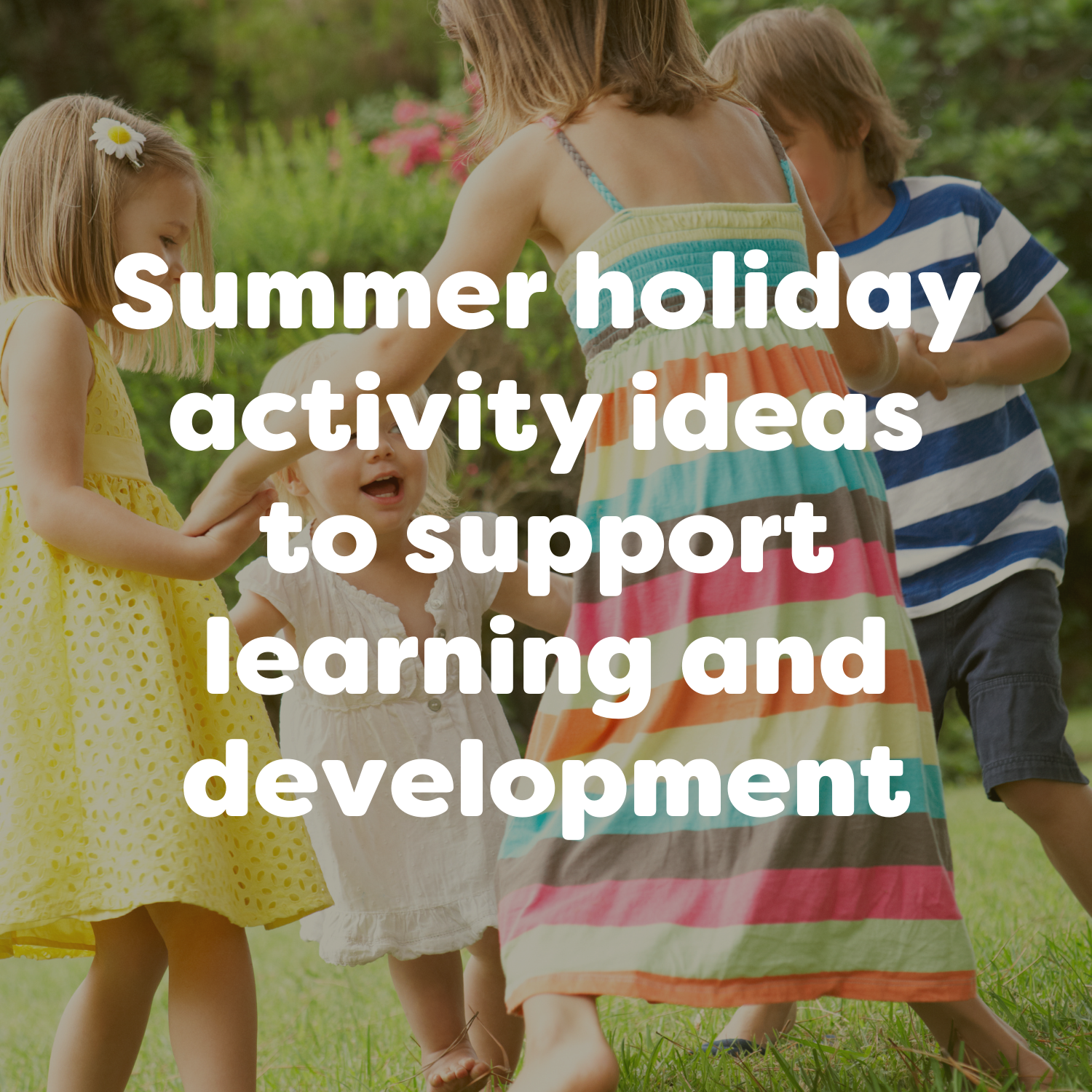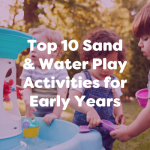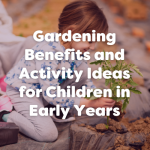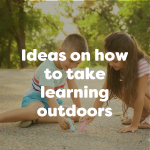School’s out! Which means it’s time to have some summer fun. With the summer holidays nearly in full swing for children across the country, they will be eager to let their hair down and let loose. No need to scramble and think of ways to keep your little one’s entertained this summer. We’ve come up with a host of activity ideas for you to try indoors or outdoors that will continue to support learning and development through the upcoming glorious summer months.
Summer Scavenger Hunt

Scavenger hunts are a fantastic activity for young children and do not have to involve any particular resources. You can draw up your own hunt OR download our FREE summer scavenger hunt and explore!
A little imagination goes a long way. If you’re creating your own hunt, you could try to incorporate your child’s unique interests. If they like picking flowers or gardening, you could make it nature-themed, or if they enjoy painting, you could make it art-related. Perfect for the unpredictable British Summer, a scavenger hunt can also be done indoors with the simplest of items gathered from around the house. Make your scavenger hunt straightforward, or make it more challenging with riddles and clues! Let your children get up close and personal with nature as they embark on a scavenger hunt with our magnifying glasses set!
Scavenger hunts can be engineered to promote learning and development in various areas for example, why not ask children to seek out different coloured items and afterwards count what they have found?
Links to Learning
- Scavenger hunts are a great way to get children outside and encourage outdoor exploration in a fun and exciting way
- They also encourage them to use their problem-solving and observation skills to seek out hidden gems
- It offers a sense of independence for children as they seek out the individual items on their own
- It can help children better understand the world and promote discussions around season change, weather, travel, animals etc.
- These discussions, in turn, promote communication and language development as children learn new words, improve listening skills and follow instructions
Den Building

“A den is a child’s chance to create a home away from home that is secret and becomes a manifestation of who they are” – David Sopel, Developmental Psychologist.
A den can become a majestic castle, a mysterious cave or a little house, the possibilities for imaginative play are endless.
Den building does not have to be restricted by resources or space! An indoor den can be made from typical household items like chairs, blankets and sofa cushions. You can take the den building to the next level and head outside with some waterproof fabric, sticks and branches or use the EYR den kit and find all you need to create the most spectacular den! Why stop there? Add a little extra creativity and excitement by kitting out the inside of your indoor or outdoor den. You could add one of our Ultrasoft Play Mats or other small world resources.
If you’re not sure where to start check out our top 10 den play activities.
Links to learning
- Den building is a great way to spark creativity and imagination but also provides children with a sense of independence and allows them to challenge themselves and problem solve
- Outdoor den building offers the added bonus of exploring the natural world and testing different materials which makes it a great activity for the summer holidays
- The physical act of building a den involves gross motor skills through lifting, moving, carrying and fine motor skills through gripping, manipulating and tying knots
- Communication and language also improves with den building as children learn new vocabulary and practice using instructions, descriptions, actions (such as weave, thread, stack) and positional language (such as on top, next to, underneath)
Sand Play

Bring the beach to you!
The opportunities for learning are endless, even in its most basic form, sand provides children with a blank canvas for practising mark making and writing, an activity for any age. Younger children can draw lines, squiggles and movements in the sand, all of which will contribute to letter formation and older children can practice words, letters and numbers in the sand and simply wipe their work away after.
Asking children to create a drawing in the sand is a similar activity, it is a great way to keep them entertained and offers a different experience to the classic paper and pencil.
A treasure hunt is another great way to use your sandbox, simply hide your toys in the sand and let the children have fun finding them using their hands, scoops and spades. Why not try hiding some dinosaur fossils or figures and create a mini excavation site?
Links to learning
- Playing in sand is a fantastic activity for developing motor skills, including hand-eye coordination and strengthening muscles
- It also offers a sensory, immersive and calming experience that cannot be replaced with modern technology or TV
- Sand play can also offer the unexpected benefits of increased immunity. Research shows that children who play outdoors in the grass, sand or dirt have healthier immune systems than children who are constantly in sterile, indoor environments.
Water Play

Water play is another activity that doesn’t have to be defined by resources or space. A bath, bowl or bucket are typical household items that can hold water. Children can explore materials and their properties by predicting and testing which household items will float or sink.
Another way to explore scientific properties is through ice play – this activity will need a little extra planning but is perfect for a hot summer’s day. Freeze toys in various sized containers or ice cube trays and give children some warm water, pipettes, salt etc. and let the fun begin!
Finally, a washing station is a great way to keep children occupied and is also a wonderfully simple Montessori activity. Simply fill a bucket with warm soapy water and add some toys/clothes and various cleaning utensils like sponges and clothes and let the children clean their toys.
*Remember that water play should always be supervised*
Links to learning
- Water play is a great sensory experience that can be used for effectively calming children that are overwhelmed.
- It can offer a whole host of learning opportunities; water play allows children to practice skills like problem-solving, logical thinking, maths, science, language and social skills in a hands-on way and in a real-world environment
- Water play lets children use large and small muscles and is a great way to develop their motor skills, for example, as they fill up and pour from buckets or ring out sponges
Crafts

At home crafts are such a simple and fun way to keep children occupied for hours on end. For a quick and easy craft, why not try to recreate our playdough ice cream?
Another great activity for the summer holidays is to encourage children to create and write a postcard detailing everything they have done in the time they have been off school. Once they have created their masterpiece, why not post the card to a friend or family!
Creating transient art is another fantastic summertime activity. Children can collect treasures from their garden, walks they’ve been on or simply from their home and assemble them into a masterpiece that can be amended or redone. (Learn more about transient art.)
Links to learning
- Crafts can be used to promote so many areas of learning. For example, designing and writing a postcard to a friend or family is fun and creative, but it also improves children’s language and communication
- Similarly, creating ice cream out of playdough may seem like a simple activity but is also great for improving fine motor skills as the act of moulding the dough into shape builds up strength and muscles in their hands. Which is useful for future activities such as holding a pencil in lessons
- Finally, creating transient art pieces not only encourages creativity but it requires children to develop concepts, plan, and represent ideas which also improves concentration and the ability to complete tasks
Physical Activity

There are so many opportunities to get the children out, about and moving during the summer holidays.
Physical activity can be as simple as going for a walk in nature around your local area, but with the Olympics just around the corner, why not try and create your own at home Olympics? Sports like a relay race, hurdles, discus, long jump or shotput can be replicated easily with just a few resources!
Another physical activity to try at home is a treasure hunt! Hide one or two items in and around your home and provide children with a map and clues to find the treasure!
A day outdoors in the fresh air spending time with family is a day well spent. You could visit the seaside or go to your local play area or nature reserve. These options are easily accessible and open to everyone!
Links to learning
- Besides the obvious benefit to physical development (gross and fine motor and muscle strengthening), physical activity also boosts brain power and cognitive ability. This then enhances brain function, concentration and memory. All of which are vital for children’s learning and development.
- Similarly, research has shown a positive correlation between a child’s performance in school and their level of physical fitness, indicating that children who engage in exercise regularly are likely to perform better in school.
- Finally, physical activity elevates mood and reduces anxiety through the release of endorphins. It contributes to increased self-esteem and children’s sense of accomplishment and positivity, making them more likely to learn and retain new information.
In the Garden

Spending time in the garden is a great way for children to get outdoors during summer. Why not start the holidays by planting various vegetables or plants that children can water and look after throughout their time at home? Carrots, French beans and spinach are all vegetables that can be planted mid-summer.
Despite the obvious implications, you don’t need to have a garden to do gardening, window boxes and indoor plants work just as well, why not try planting different herbs or a tomato plant on the windowsill?
Take advantage of the beautiful sunshine and hold a teddy bears’ picnic. Have your child bring their favourite teddy, grab some snacks and juice/water, and play some music!
Links to learning
- These garden based activities are a great way to keep children occupied throughout the summer holidays and will provide them with a sense of responsibility and patience as they care for the plants.
- They will also develop a deeper understanding of cause and effect, for example, plants die without water, and this contributes to children’s well rounded knowledge of the world around them.
- Growing plants and vegetables is a great way to introduce concepts of sustainable and healthy living. It can also help build positive attitudes towards healthy eating habits.
Something to remember when planning summer holiday activities for you and your child(ren) is that any and all activities can be manipulated and angled towards learning in some way. Even if all else fails, the most basic of activities remain beneficial to development such as reading, writing, colouring, imaginative play and walking around your local area.
We would love to see what you get up to in the summer holidays, tag us on Instagram or use the hashtag #explorewithEYR to share your activities and ideas!





